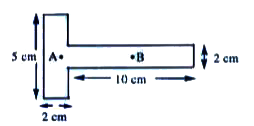A particle of mass 0.2 kg is moving with linear velocity (i−j+2k). If the radius vector r=4i+j−k, the angular momentum of the particle is Solution in Telugu
2.14 units
√4.28 units
√107 units
5 units
The correct Answer is:B
Step by step video, text & image solution for A particle of mass 0.2 kg is moving with linear velocity (i-j+2k). If the radius vector r=4i+j-k, the angular momentum of the particle is by Physics experts to help you in doubts & scoring excellent marks in Class 11 exams.
Topper's Solved these Questions
- BOOK - AAKASH SERIESCHAPTER - SYSTEM OF PARTICLES AND ROTATIONAL MOTIONEXERCISE - EXERCISE - 361videos
SYSTEM OF PARTICLES AND ROTATIONAL MOTION
- BOOK - AAKASH SERIESCHAPTER - SYSTEM OF PARTICLES AND ROTATIONAL MOTIONEXERCISE - EXERCISE-I (Centre of Mass)40videos
SYSTEM OF PARTICLES AND ROTATIONAL MOTION
- BOOK - AAKASH SERIESCHAPTER - SYSTEM OF PARTICLES AND ROTATIONAL MOTIONEXERCISE - EXERCISE - 1B51videos
SYSTEM OF PARTICLES AND ROTATIONAL MOTION
- BOOK - AAKASH SERIESCHAPTER - SURFACE TENSIONEXERCISE - ADDITIONAL PRACTICE EXERCISE (PRACTICE SHEET (ADVANCED) INTEGER TYPE QUESTIONS )8videos
SURFACE TENSION
- BOOK - AAKASH SERIESCHAPTER - THERMAL PROPERTIES OF MATTEREXERCISE - ADDITIONAL PRACTICE EXERCISE (LEVEL - II) PRACTICE SHEET (ADVANCED) Integer/Subjective Type Questions2videos
THERMAL PROPERTIES OF MATTER
Similar Questions
The C.M of a uniform card board cut in .T. shape as shown in figure is
 01:39View Solution
01:39View SolutionThree identical spheres each of radius R are placed touching each other on a horizontal table. The centre of mass of the system is located
03:37View Solution(A) : Position of centre of mass of a body (w.r.t body frame) is independent of co-ordinate system.
(R ) : Internal forces do not effect the motion of centre of mass.03:00View SolutionIf the work done in blowing a soap bubble of volume 'V' is W, then the work done in blowing a soap bubble of volume '2V' is
02:12View SolutionA constant pressure gas thermometer has a volume of 200cc, 273.2cc and 525 .1cc at 0°C, 100°C and boiling point of sulphur respectively. The resistance possessed by a platinum wire at the same temperatures as above are 2.000Ω,2.778Ωand5.280Ω respectively. Estimate the boiling point of sulphur on the basis of the two sets of observations.
07:28View SolutionThe linear velocity perpendicular to radius vector of a particle moving with angular velocity omega=2hatK at position vector r=2hati+2hatj is
02:51View Solutionद्रव्यमान m का एक कण, त्रिज्या r के वृत्त पर नियत चाल से चल रहा है। वृत्त के केंद्र के परितः कण का कोणीय संवेग J है। कण पर अभिकेंद्र बल है:
01:28View SolutionLinear momentum vec(P)=2hat(i)+4hat(j)+5hat(k) and position vector is vec(r)=3hat(i)-hat(j)+2hat(k) , the angular momentum is given by
01:57View Solutionएक कण का स्थिति सदिश →R=5ˆi−6ˆj+6ˆk तथा कोणीय →ω=3ˆi−4ˆj+ˆkवेग है | इसका रेखीय वेग होगा -
02:58View Solutionदो कण जिनके वेग सदिश क्रमश: (ˆi+ˆj+ˆk)
तथा (2ˆi+2ˆj+2ˆk) मी. / से हैं , द्विकन निकाये का निर्माण करते हैं । कणों के द्रव्यमान क्रमश: 1 किग्रा व 2 किग्रा हैं । कण तंत्र का द्रव्यमान केंद्र के सापेक्ष कुल रेखीय संवेग ज्ञात कीजिए ।03:54View SolutionThe angular velocity of a particle,→w=3ˆi−4ˆj+ˆk and its position vector, →r=5ˆi−6ˆj+6ˆk. What is the linear velocity of the particle?
03:42View SolutionThe radius vector vec r=2i+5k and the angular velocity of a particle is vec w=3i-4k Then the linear velocity of the particle is
View SolutionThe radius vector vec r=2i+5k and the angular velocity of a particle is vec w=3i-4k .Then the linear velocity of the particle is
02:33View SolutionThe angle between the vectors 2i−3j+k and 4i+j−2k is given by
05:06View Solutionm द्रव्यमान वाला एक कण एक समान वेग से r त्रिज्या के वृत्ताकार पथ पर गति कर रहा है । यदि कण का कोणीय संवेग L है अभिकेंद्रीय बल का मान होगा
View Solution

